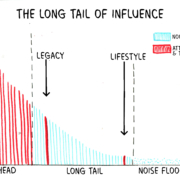3 Things Thought Leaders Do Differently
We need to talk about alchemy.
Yep, alchemy.
Here’s a quick story to explain why this is so important to your success. The day after my daughter was born, I remember hungrily rummaging through the kitchen for something to eat (groggy from a long night of waking up every 45 minutes to see if the baby was still breathing).
I opened the fridge…nothin’
Looked in the pantry…meh
Checked all the cupboards…yawn
Somehow we’d forgotten to stock up on groceries! That’s when my mom (who had flown in to help out) walked into the kitchen and told me she’d handle lunch. Thirty minutes later, she’d magically turned bits of leftover rotisserie chicken, a handful of vegetables, and a few things from the pantry into a delicious vegetable soup. My mom has always been a sort of alchemist with food.
In 8th century Europe, alchemists believed they could make a common metal, such as lead, more valuable by turning it into gold. Much like these alchemists, my mom could take common resources (food items that seemed uninteresting and useless to me) and turn them into something of elevated value — a yummy meal that solved our hunger.
This is a lot like what entrepreneurs and thought leaders do.
Thought leaders and entrepreneurs perform alchemy by turning resources, knowledge, and relationships into something of greater value by using them to create unique solutions that solve problems and fulfill unmet needs.
Your intended audience is willing to pay and support you because of this.
The 3 things thought leaders do differently
The more you are able to invest your time and energy into this “entrepreneurial and thought leadership alchemy,” the more your income, impact, and influence will grow. In your day-to-day, this focus consists of three activities:
Creating, relating, and ideating.
The more you get pulled away from focusing time on those three areas, the more you lose the value you could have otherwise created (impact) and captured (income) with that time and energy — even if that time and energy are spent on other areas of your business. This leads to an important point:
Everything in your business is part of a system with one sole purpose: to support you in being a needs-fulfilling, problem-solving machine that creates, relates and ideates in a way that only you can because of who you are, how you think, and how you show up in the world.
In other words, your business exists to maximize how much you are able to create, relate, and ideate (or your “CRI focus” for short).
Creating consists of activities where you imagine, design, and produce things like content and other intellectual property. This drives marketing, sales, and product development.
Relating has a few meanings. First, this is where you deliver (relate) the product or service to your customers (e.g. online training calls, retreats, events, coaching, etc.)
This also includes time spent interacting with your market for the purpose of finding and understanding unmet needs that you can solve.
Finally, it refers to developing key relationships that enhance your work.
Ideating is the often overlooked (or sacrificed) time and space invested into absorbing, researching, thinking, imagining, processing and synthesizing. This is what allows you to show up, think, and create in a way that only you can. This is what takes your brand from being one of many to being the authoritative and unique only one who does what you do, for the purpose of marketing, sales, or product development. For thought leader entrepreneurs this includes things like designing courses, content, or other products and services that you sell.
This is how leading thought leaders operate. This is how they become world-class brands with enormous reach, recognized for their unique voice and ideas. If you’re feeling like there’s something bigger for you and your business, this is how you make that leap.
CRI focus in action
Doing this requires understanding exactly what creating, relating and ideating look like in action. Then you have to identify what aspects of your work truly require your focus and which you can hand off to others. (This is where I see a lot of people get held back.)
You then increase your CRI focus by making key changes over time to your mindset, business model, and support systems. The problem is that so often we get pulled into adding tactics, team members, systems and other pieces to our business that don’t increase our CRI focus.
In fact, what typically happens is our CRI focus goes DOWN as time goes on. For a time our business grows, then inevitably we hit a bottleneck. We hit a plateau, burn out, lose sight of our vision, stagnate, and never make the leap from a lifestyle business to a business that fuels our big vision and legacy.
So take a quick guess: What percentage of your time and energy do you focus on creating, relating, and ideating? Identifying how much time you’re currently spending on these areas is the first step to developing a more productive ratio.






Leave a Reply
Want to join the discussion?Feel free to contribute!